Whether you’re following a keto diet or simply looking to cut some calories, I have you covered. In this guide you’ll find nine low carb substitutes for potatoes with nutrition breakdowns and recipes for how to use them. We’re talking about low carb mashed and scalloped potatoes, fries and sweet potato fries, tots and fritters, potato salad, soups and pot roasts, hash browns, and more.
From one potato lover to another, I guarantee you’ll find something you love here.
Low Carb Root Vegetables
We’ll get to the usual suspects like cauliflower momentarily. But first, let’s take a look at some of my personal favorite low carb potato substitutes—root vegetables—and how to cook them.
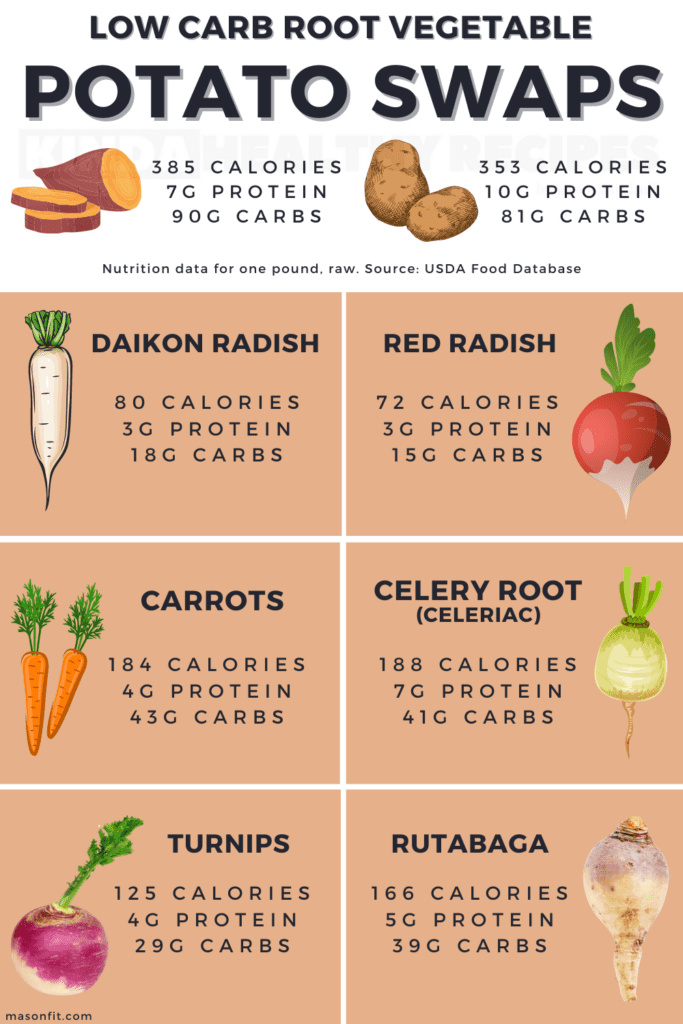
All the nutrition information you’ll find in this guide is for one pound of each option and has been sourced from the USDA Food Database. Since every keto potato substitute in this guide is nearly fat free, I’ve omitted that macronutrient.
You rarely use just a cup of raw potato or sweet potato, so I felt a pound (about 2 potatoes) was a fair comparison. As you can see in the graphic above, one pound of russet potatoes has 353 calories, 10g of protein, and 81g of carbs. And a pound of sweet potatoes has 385 calories, 7g of protein, and 90g of carbs.
1. Turnips
With a mild flavor, especially when cooked, turnips are one of my favorite low carb potato substitutes. You can mash, roast, cut into fries or hash browns, or do just about anything you’d use potatoes for.
There are lots of turnip varieties, but you’ll find the purple top turnips in most grocery stores. Not to be confused with the more yellow rutabaga, which we’ll get to in a moment. Other varieties to look out for include jicama (Mexican turnip), hakurei (Japanese baby turnip), and kohlrabi (German turnip).

Turnips Nutrition Info (one pound raw):
- 125 Calories
- 4g of Protein
- 29g of Carbs
Turnips’ vitamin and antioxidant contents may provide anti-inflammatory, anticancer, and antibacterial effects, among other benefits.
Ariane Lang, BSc
Ways to Swap Turnips for Potatoes

- air fryer roasted turnips
- low carb scalloped kohlrabi or keto scalloped turnips
- keto breakfast potatoes
- low carb clam chowder
- mashed turnips
- turnip fries or jicama fries
- jicama bravas
2. Daikon Radish
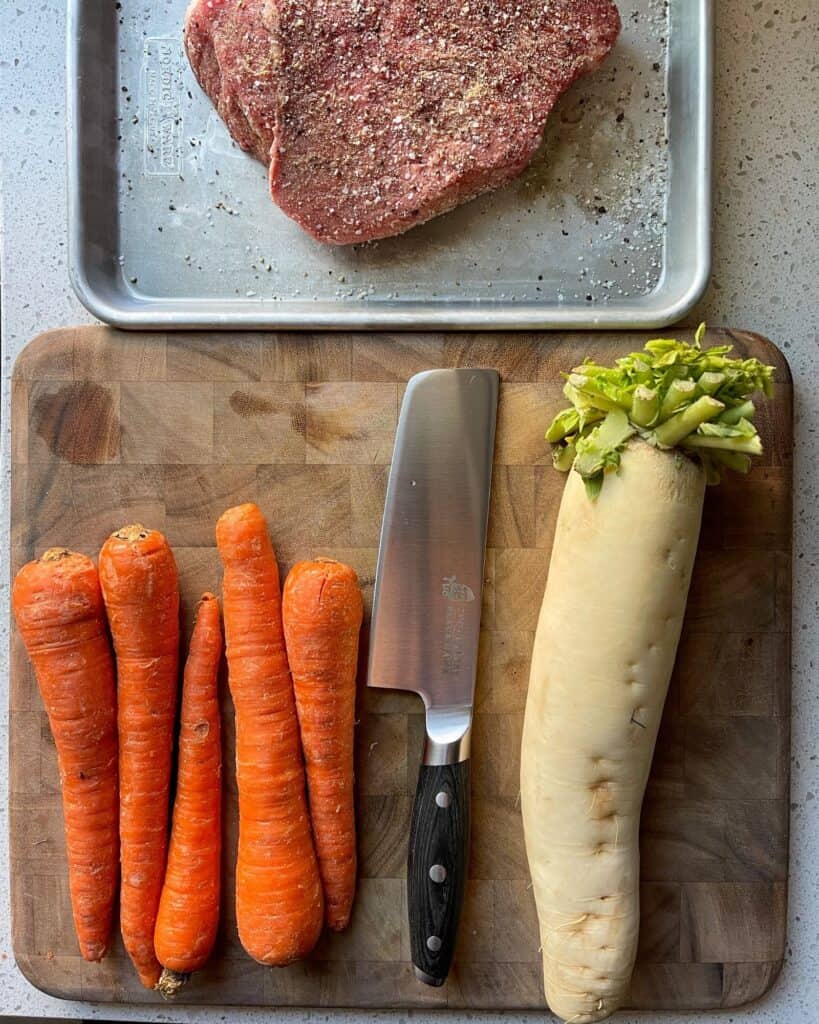
Also known as a Chinese, Japanese, or luobo radish, this root vegetable is less peppery than a red radish and becomes mildly sweet and tender when cooked. Traditionally, daikon is used in lots of soups and curries. I think it’s perfect for things like pot roast or wherever you’d use slower cooked russet potatoes.
Daikon Radish Nutrition Info (one pound raw):
- 80 Calories
- 3g of Protein
- 18g of Carbs
Like most of the vegetables on this list, daikon packs a solid punch of filling fiber. It also contains polyphenols and antioxidants that may reduce inflammation and boost the immune system.
Ways to Swap Daikon Radish for Potatoes

- pressure cooker pot roast
- keto potato salad
- crispy daikon fries
- keto fauxtatoes
- daikon and sausage casserole
3. Red Radishes
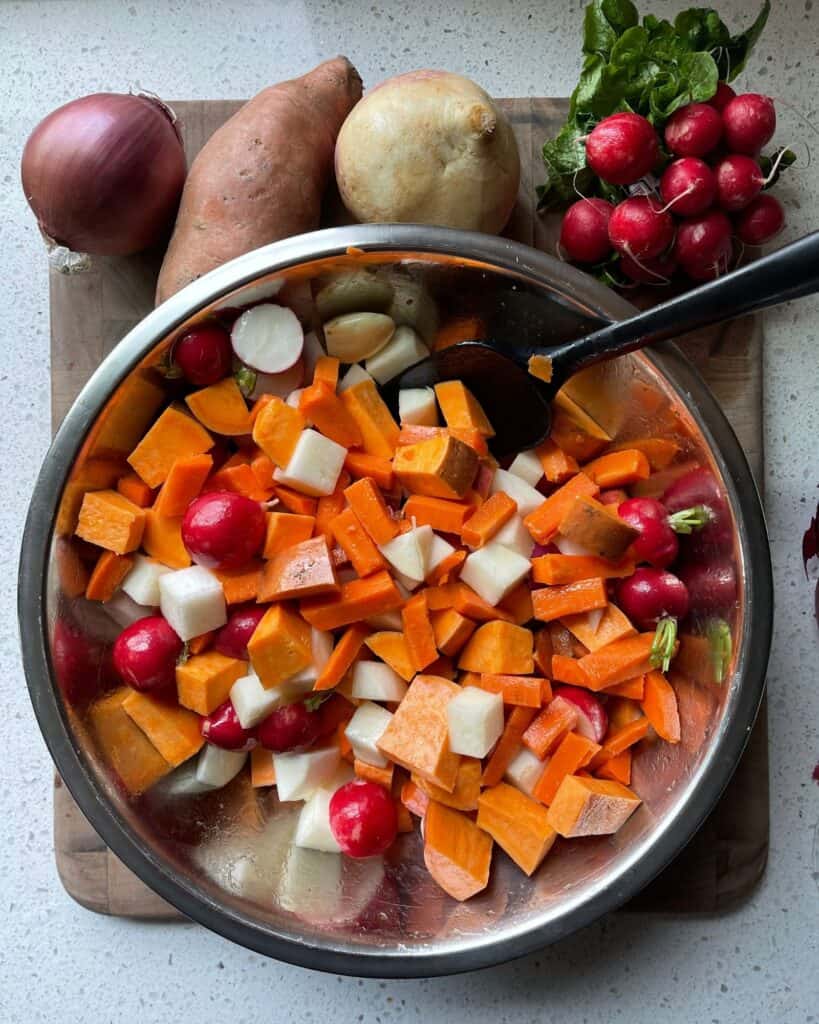
Red radishes might be my favorite vegetable on this list, and that’s because they’re the perfect low carb substitute for baby gold potatoes. And I absolutely love baby potatoes.
Red Radishes Nutrition Info (one pound raw):
- 72 Calories
- 3g of Protein
- 15g of Carbs
Weighing in as the lowest calorie option in this guide, red radishes are also packed with Vitamin C, minerals like potassium and calcium, and good ol’ fiber.
Ways to Swap Radishes for Potatoes

- keto bacon cheeseburger skillet
- potato-less potato salad
- low carb breakfast sausage skillet
- air fryer roasted radishes
Or like I mentioned above, any recipe with baby potatoes like my air fryer breakfast potatoes or Greek chicken and potatoes.
4. Carrots
Ah, something a bit more familiar. I view carrots as more of a low carb sweet potato substitute than russet or yukon gold potatoes, due to its color, flavor, and texture. You can also lump parsnips in with carrots, though they have more carbs than you might think.
Carrots Nutrition Info (one pound raw):
- 184 Calories
- 4g of Protein
- 43g of Carbs
Known for their eyesight improving (that’s a myth, by the way) levels of beta carotene, carrots are also a great source of fiber, potassium, and other antioxidants.
Ways to Swap Carrots for Potatoes

- crispy carrot fries (that readers swear are sweet potato fries)
- oven roasted carrot sticks
- air fryer roasted carrots and potatoes (you could swap potatoes for turnips/radishes)
- mashed ginger carrots or mashed sweet potatoes and carrots
- carrot and parsnip hash browns
5. Celeriac (Celery Root)
Don’t judge a book by its cover. While this bumpy turnip-look-a-like is rough around the edges, it’s very similar to a potato once peeled (which you’ll want to do with a knife instead of a vegetable peeler).
This root veggie can be a bit trickier to find in some grocery stores, but I felt it could use a little attention. So keep an eye out and pick some up if you ever run across it at a farmers market.
Celery Root Nutrition Info (one pound raw):
- 188 Calories
- 7g of Protein
- 41g of Carbs
Celeriac is high in antioxidants and certain nutrients that are associated with health benefits. These include protection against certain cancers and improved digestion, as well as heart and bone health.
Mary Jane Brown, PhD, RD
Ways to Swap Celery Root for Potatoes

- baked celery root fries
- celery root puree (as a mashed potatoes substitute)
- celeriac mash
- celery root soup
- herb roasted celeriac
6. Rutabaga (Swede)
If nothing else, I say try this low carb potato alternative based solely on its name. I mean, how fun is it to say rutabaga?
On a serious note, I mentioned rutabaga above in the turnips section, and that’s because they’re quite similar. What’s the difference between a turnip and rutabaga?
Turnips and rutabagas are both members of the cabbage family, Brassicaceae. The rutabaga is thought to be an ancient cross between a turnip and a cabbage, and therefore a hybrid. Turnips are usually white and purple on the outside, with very white flesh, while rutabagas are yellowish and brown on the outside with orange-yellow flesh. Rutabagas are also generally much larger than turnips.
Danilo Alfaro
A key difference is the larger size of rutabagas. If you need larger cuts of veggie for something like fries or scalloped fauxtatoes, rutabaga may edge out turnips.
Rutabaga Nutrition Info (one pound raw):
- 166 Calories
- 5g of Protein
- 39g of Carbs
Rutabagas are an excellent source of potassium, calcium, magnesium, and vitamins E and C. They also contain a moderate amount of folate, a B vitamin that’s important for metabolism, protein synthesis, and DNA replication.
Katey Davidson, MScFN, RD, CPT
Ways to Swap Rutabaga for Potatoes
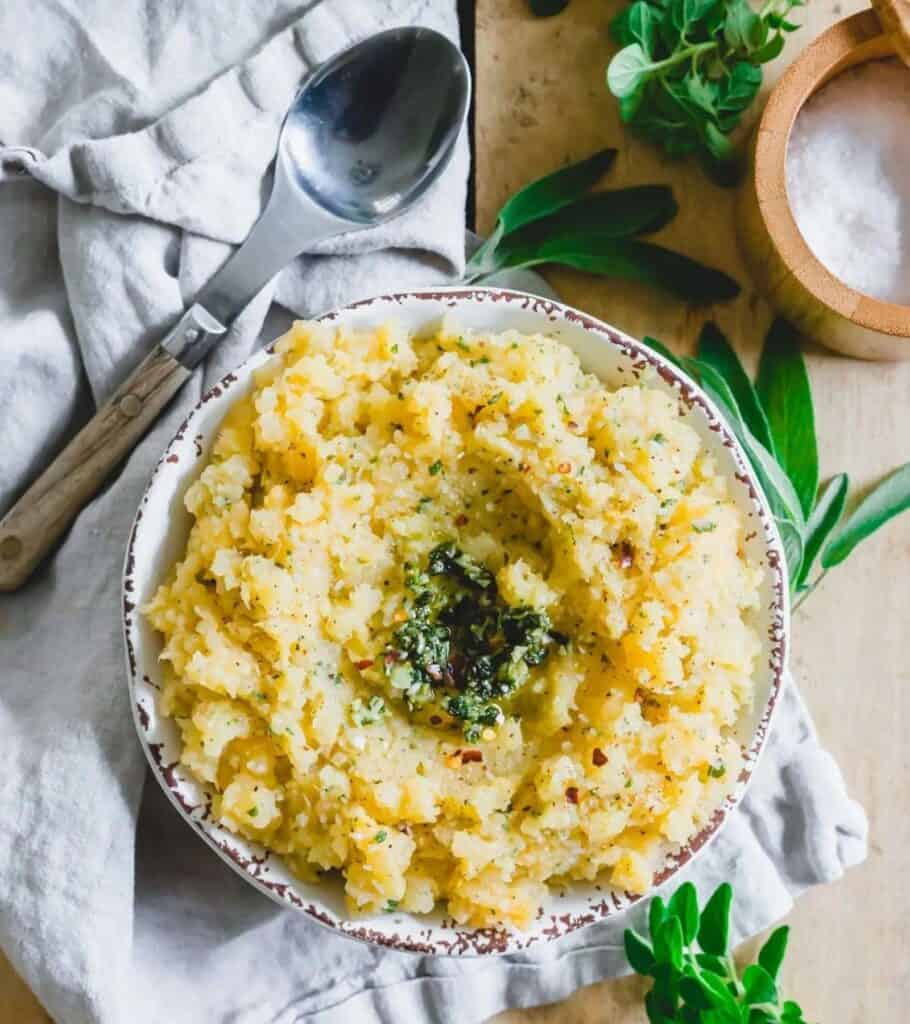
The Other Usual Suspects
My love for root veggies runs deep (See what I did there?), but they’re not the only game in town. Let’s take a look at three familiar foods that work as a low carb substitute for potatoes.
7. Butternut Squash
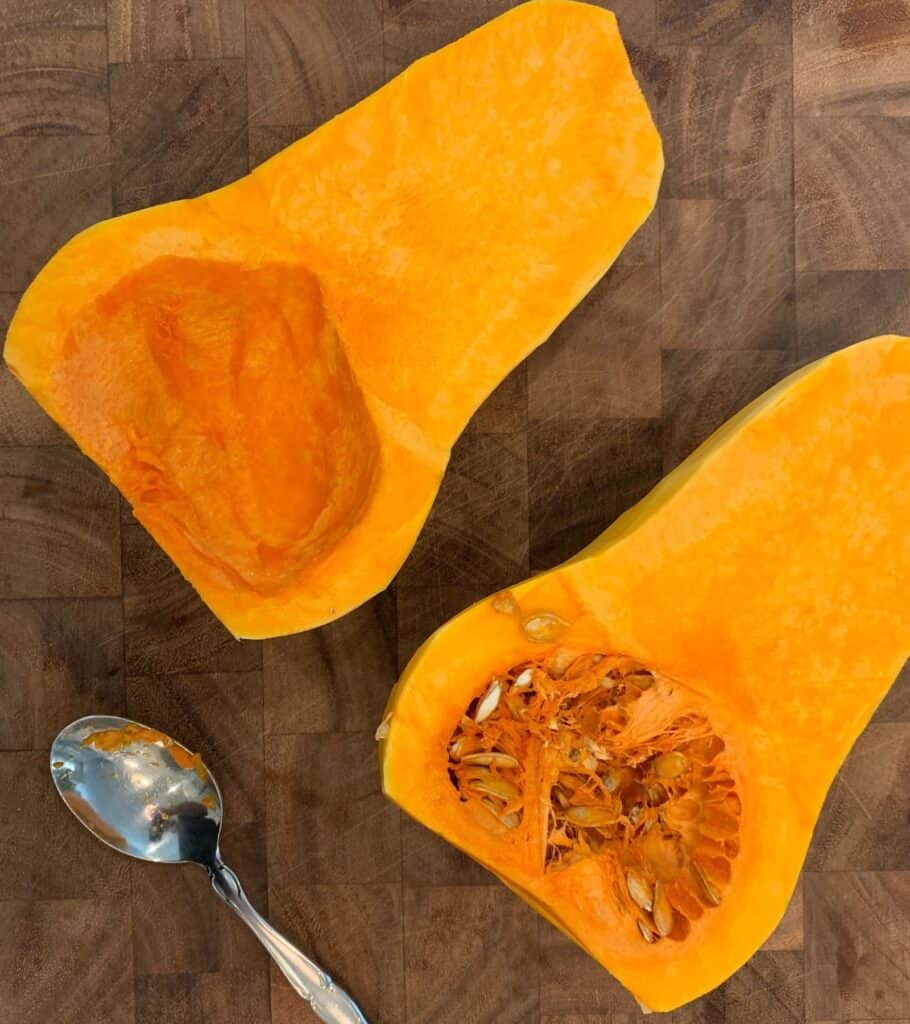
When it comes to keto sweet potato substitutes, it doesn’t get much better than butternut squash. Mash, roast or air fry, use in soups, or make your favorite low carb potato snack like tots or fries. (Though I personally prefer carrots for fries.) And thanks to its growing popularity, you can find plenty of convenient options like pre-cut butternut squash zig zags, cubes, noodles, and more.
Butternut Squash Nutrition Info (one pound raw):
- 202 Calories
- 4g of Protein
- 52g of Carbs
The high antioxidant content of butternut squash may reduce your risk of certain conditions, including heart disease, lung cancer, and mental decline.
Jillian Kubala, MS, RD
Ways to Swap Butternut Squash for Potatoes

- mashed butternut squash
- air fryer roasted butternut squash
- butternut squash fries
- roasted butternut squash hash
- butternut squash latkes
8. Cauliflower
This is the big one. We’ve all become familiar (maybe too familiar) with cauliflower as a keto substitute for potatoes, rice and grains, and just about every other carb source.
Cauliflower Nutrition Info (one pound raw):
- 112 Calories
- 9g of Protein
- 22g of Carbs
I think we can all agree that cauliflower is a stinky boy, and that’s due in part to all its plant compounds that work their magic in more than just your olfactory system. Sulforaphane, glucosinolates, flavonoids, choline—you name it, and cauliflower’s got it.
Ways to Swap Cauliflower for Potatoes

- mashed cauliflower
- loaded baked “potato” casserole
- cauliflower “potato” salad
- loaded cauliflower soup
- keto zuppa toscana
- low carb cottage pie
- cauliflower and kale tots

There are also plenty of pre-made cauliflower substitutes like frozen tots, mashed fauxtatoes, pizza crust, and gnocchi. I personally enjoy the cauliflower gnocchi options. Here are a few ideas to make with it:
- air fried cauliflower gnocchi
- vegetable gnocchi soup
- chicken sausage and mushroom cauliflower gnocchi
9. Zucchini
While it’s a little tricky to get zucchini crispy due to its high water content, it’s great in a hash, casserole, or as a vessel like a potato skin.
Zucchini Nutrition Info (one pound raw):
- 76 Calories
- 5g of Protein
- 14g of Carbs
Zucchini packs a carotenoid punch, which is great for skin, bone, and cardiovascular health.
Ways to Swap Zucchini for Potatoes

- zucchini fritters
- keto zucchini fries
- zucchini potato bake (could swap potatoes for a lower carb option above)
- twice baked zucchini
- zucchini boats
- hasselback zucchini
Wrapping Up
To recap, here’s the complete list of all nine low carb potato swaps:
- Turnips
- Rutabaga
- Red Radishes
- Daikon Radish
- Celery Root
- Carrots
- Cauliflower
- Zucchini
- Butternut Squash
I hope this guide was helpful. If it was, let me know in the comments or by sharing this post. And if you have any awesome keto potato recipes to share or other potato swaps I forgot to mention, you can leave those in the comments as well.
Happy cooking! I’m rooting for you.
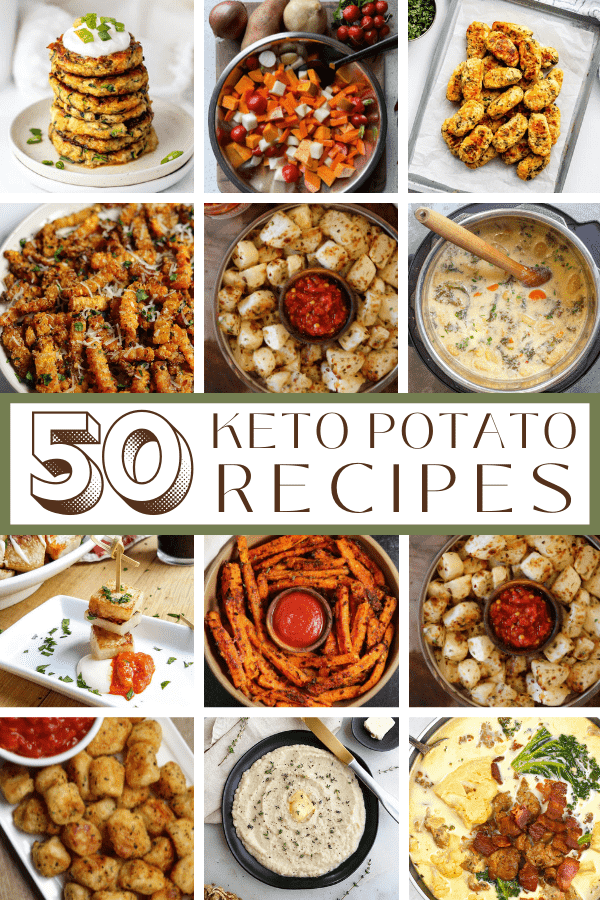

Patty
Thursday 27th of June 2024
This is an awesome list. Normally, I would not eat these vegetables except in a fancy restaurant, which is rare. Things on this list are now my regular go to's because of recent diagnosis of Diabetes II. Not only do they have less carbs, but they are less starchy root vegetables with more water content.